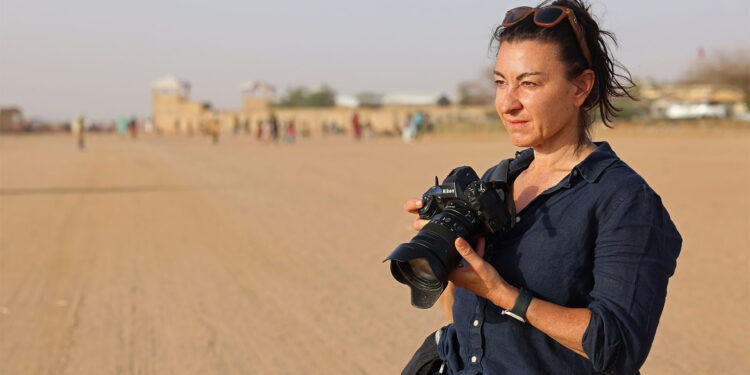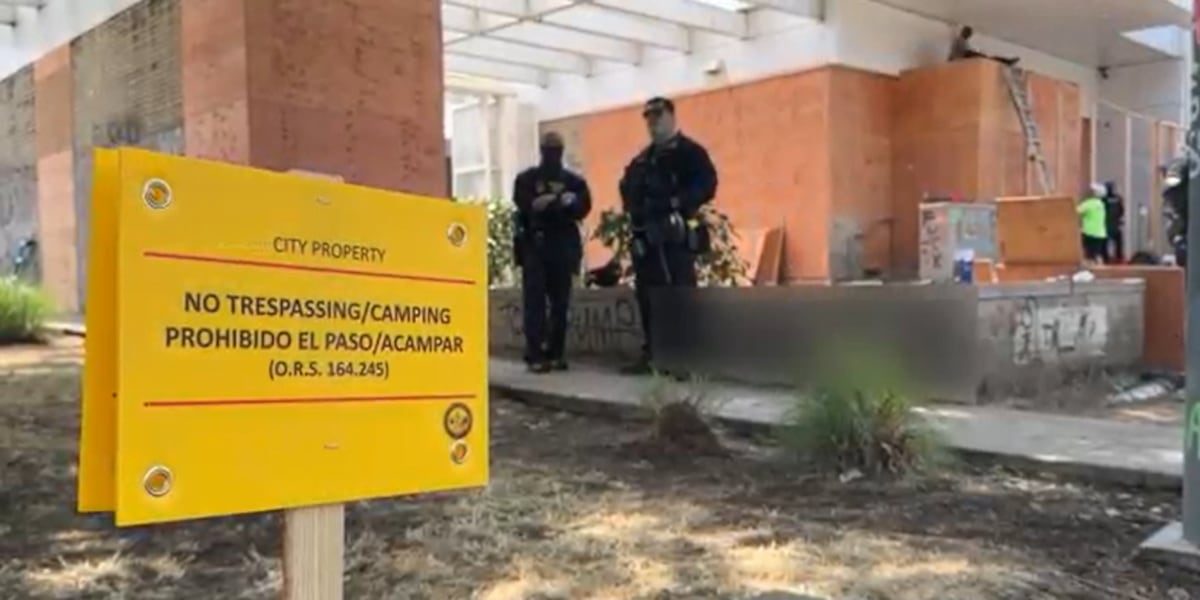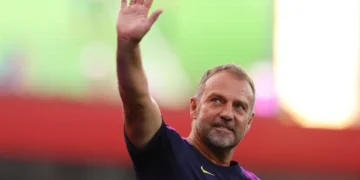Lynsey Addario on assignment in Iridimi Refugee Camp, Wadi Fira, Chad. (National Geographic/Caitlin Kelly)
Pulitzer Prize-winning photographer Lynsey Addario has risked life and limb and been kidnapped multiple times to perform a photojournalist’s most crucial and valuable mission: powerfully capturing and telling the world’s most meaningful stories. Addario’s incredible career, which spans more than two decades, is the focus of the brand-new National Geographic documentary, Love+War.
In the new documentary, viewers get a behind-the-scenes look at how Addario balances her work in dangerous places — including, most recently and frequently, war-ravaged Ukraine — with her personal life. Addario is often away from her husband and kids for weeks and even months at a time, living and working abroad in extreme danger. Every time she leaves home on assignment, she incurs significant risk and pays a steep price.
However, Addario, whose acclaimed work has transformed how people perceive global conflict and its effects on people, especially women and children, remains driven to do it all: Capture world-changing photos and return safely home to be with her family. How she navigates these competing passions is central to the film and yields some of its most powerful scenes about what it means to be a conflict photographer.
Revisiting a Career of Remarkable Accomplishment and Near-Death Experiences
Throughout Love+War, Addario recounts many of the most significant experiences from her career, both good and bad, but always emotionally powerful.
“I think it’s been hard to revisit a lot of these situations and a lot of these images,” Addario tells PetaPixel. “I have been doing this a very, very long time, almost 25 years, and a lot of the people I’ve photographed over the years still live with me and I carry their stories with me.”
Lynsey Addario on assignment in Iridimi Refugee Camp, Wadi Fira, Chad. (National Geographic/Caitlin Kelly)
Addario says that most of the time, she’s just focused on her work. She takes the shots, then moves on to the next story that must be told. However, she says that on the relatively rare occasions when she has to sit down and really grapple with her work, “it’s difficult.”
A particularly difficult assignment was photographing Mamma Sessay, an 18-year-old mother in Sierra Leone. In May 2010, Sessay gave birth to twins. The first baby was delivered successfully, but the second child did not arrive easily — her contractions stopped. Addario traveled with Sessay as she went by canoe and ambulance from her village to a hospital, where Sessay suffered postpartum hemorrhaging and died as she was finally being brought to a doctor. The only doctor in the district, in fact.
It is stories like these, the ones that are hardest to experience and then relive, that arguably demand the most attention. The series, Maternal Mortality, is exceptionally emotional and sheds light on global tragedies as women, particularly those in vulnerable situations, face disproportionate risk as they bring new life into the world.
Addario believes that the rules of photojournalism have changed over her career. As she reflects on things she might have done differently, if given another chance, the seasoned photographer says she trusts herself more to tell the stories in the right way. Respecting the subjects is of paramount importance to Addario, and what precisely that means has changed as the ways photographs are shared and spread have changed. It is no longer the case that a photo may appear in a newspaper once and that’s it; they live online now. Forever.
Lynsey Addario on assignment in Tiné, on the Sudanese border in Northeast Chad. (National Geographic/Caitlin Kelly)
What Happens Beyond the Camera
Throughout Addario’s career, everything that happens when she’s not looking through the viewfinder has changed, too. She got married and started a family. People rarely ask men how they juggle careers and kids, and it’d be a disservice to ask Addario how she does it. However, having a family does affect her, just as it affects everyone who has to travel for work, especially when it involves going to dangerous places.
Lynsey Addario says goodbye to her son Lukas before leaving on assignment. (National Geographic/Caitlin Kelly) Lynsey Addario and her husband Paul de Bendern take a video call with Lynsey’s mother. (Credit: National Geographic/Thorsten Thielow)
“I’m at a point in my career where I’ve had so many close calls,” Addario tells PetaPixel. “I’ve now been kidnapped twice. I was through out of a car. I’ve been ambushed. I’ve lost a lot of friends.”
“I think [I do] a constant sort of calculation of what I’ll risk my life for and how far I’ll go forward with what I’m willing to do,” the photographer explains. “I think having a family adds to that equation. It’s scary. As my kids get older and as they get more aware of what I do, that calculation is even more complicated because, of course, I have to answer questions from my 13-year-old.”
Lynsey Addario at home with her son Alfred before leaving on assignment. (National Geographic/Caitlin Kelly)
She admits it was easier before she had kids, but also when they were just too young to understand what she was doing. There’s a scene in Love+War when Addario travels from Ukraine, hopping borders, to get back to England in time to go to one of her son’s recitals. It is as important a race against time as any she does with a camera in hand.
“It’s a constant negotiation with safety,” she says of her work.
After Addario was infamously held hostage and assaulted in Libya in 2011, Addario says she was constantly questioned about whether she would quit and give up her career as a conflict photographer.
“It was never a question for me,” she says, with steeled resolve. “There was never a world in which I would not do this work.”
Instead, it was a question about how she was going to continue to do her job and not get kidnapped for a third time.
Lynsey Addario photographs a damaged building in Ukraine. (Credit: National Geographic/Andriy Dubchak)
“How can I do this without putting my loved ones, my family, through that emotional toll? Because it’s very selfish in a way to continue going back, continuing going back when my family is suffering and terrified all the time. So I had to figure out how I would do it.”
Addario believes it was around this time that she started focusing more on the human stories and less on the sheer war.
“It was less about chasing the aftermath of bombs and missiles and artillery attacks and more about doing longer term stories on people and the civilian victims of combat,” Addario says. “But it’s not like anything is a guarantee in war. Everything is dangerous and everything’s unpredictable.”
Lynsey Addario finds shelter from a nearby shelling during an assignment in Ukraine. (Credit: National Geographic/Andriy Dubchak)
Lynsey Addario’s Impact on Photography and Beyond
The importance of what Lynsey Addario does cannot be overstated, nor can the price she pays to do it. Every time she travels to a dangerous region to tell real, human stories that may, in many cases, never be told otherwise, she takes a tremendous risk and must navigate dangers that few others do.
“I’m so driven. I work all the time, and I have since I was 21,” she concludes. “So long as I’m physically and emotionally prepared for a story, I’m going to go for whatever the story I want to tell is at that time. It’s important for me, the subject matter.”
Lynsey Addario holds her son Lukas while working. (Photo courtesy Lynsey Addario)
Love+War was created by Academy Award-winning filmmakers Chai Vasarhelyi and Jimmy Chin. The documentary premieres on November 6 on National Geographic, Disney+, and Hulu. It is a compelling film that all photographers should check out.











